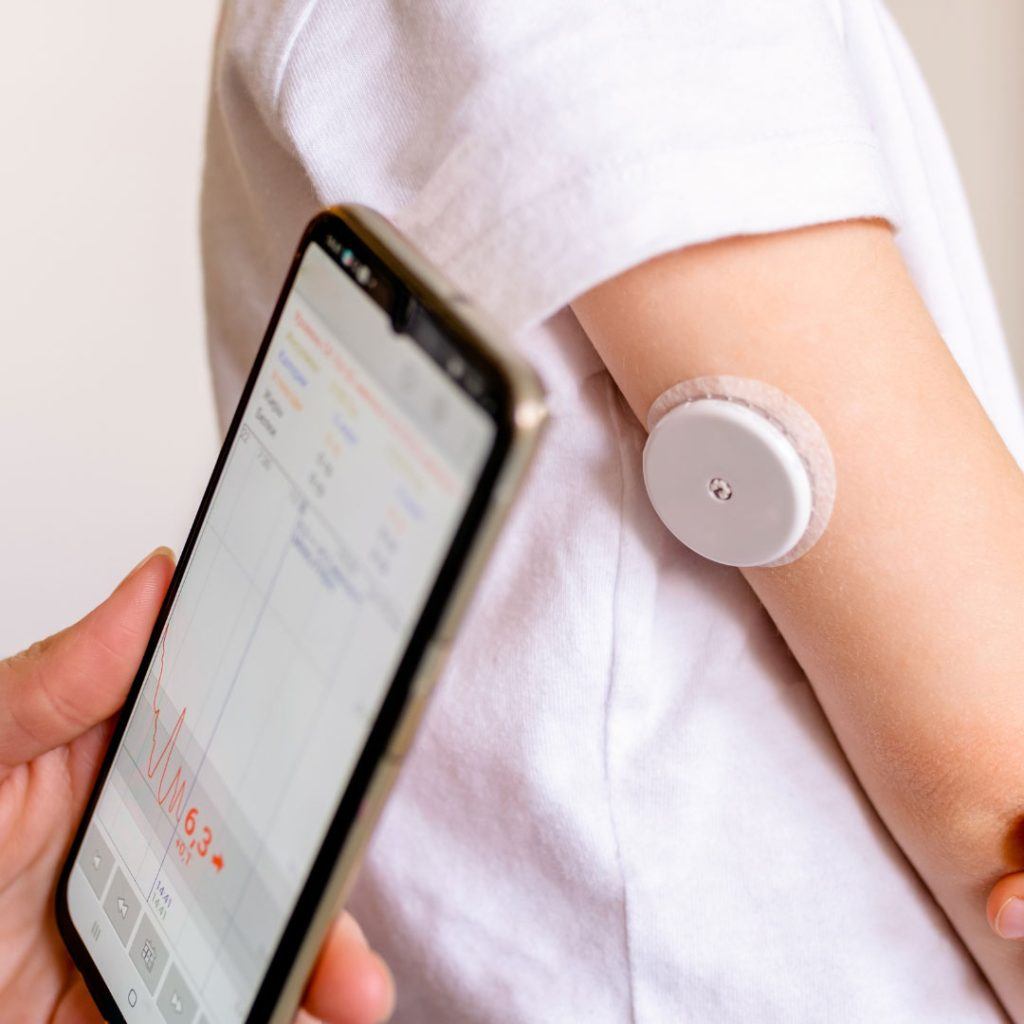Continuous glucose monitors (CGMs) make regulating blood sugar easier than ever.
By Nabeel R. Khan, MD, Internal Medicine Physician, Mount Sinai Medical Center
Managing blood sugar levels has become significantly easier since the late ‘90s, thanks to advancements in technology that have revolutionized how diabetics track their glucose. In 1999, the FDA approved the first professional continuous glucose monitoring system — a sleek, wearable device that automatically tracks and measures blood glucose levels throughout the day and night. The system uses a small sensor, typically placed under the skin on the arm, to provide real-time data directly to a smartphone.
If you have diabetes, CGMs have made glucose control smarter and more accessible over the years. Initially developed by health-tech manufacturer Medtronic, other major diabetes suppliers like Dexcom and Abbott have since introduced their own CGMs, broadening the market and making it easier for people in the United States to manage their blood sugar. According to a report[JJ1] by Research and Markets, as of March 2023, approximately 2.4 million people in the United States are using CGMs — a number that continues to grow as continuous glucose monitoring becomes increasingly popular among diabetics.
As we celebrate American Diabetes Month, it’s important to highlight the benefits of CGMs and help patients make informed decisions about incorporating this technology into their care plan.
Who Might Benefit from Using a CGM?
People who would be eligible for this device include the following:
- Type 1 diabetes patients: Especially those on insulin, as CGMs provide real-time glucose monitoring to prevent high and low blood sugar episodes, allowing more accurate and effective insulin protocols.
- Type 2 diabetes patients: Those using insulin or struggling to manage blood sugar levels can use CGMs to improve control and make informed adjustments to their medication regimen, as well as dietary and lifestyle modifications.
- Individuals seeking better glucose control: Even nondiabetics at risk of blood sugar issues (e.g., prediabetes or metabolic conditions) can benefit from better tracking.
- Athletes or active individuals with diabetes: Real-time monitoring helps adjust food, exercise, and insulin for optimal glucose control during physical activity.
- Anyone looking to improve their overall health and longevity: Research shows that even nondiabetic individuals can potentially improve longevity and decrease mortality by enhancing insulin sensitivity, improving metabolic health, and managing elevated blood sugar levels.
How a CGM Works
The sensor on this device continuously monitors glucose levels in the interstitial fluid, the liquid surrounding the body’s cells, and transmits the data wirelessly to a receiver or smartphone app. Many CGMs also display trends over time, helping users track how their activities, diet, or insulin use impact their blood sugar levels.
What Are the Benefits of Using a CGM?
- Real-time glucose monitoring
- Continuous tracking: A CGM provides real-time glucose readings every few minutes, allowing users to stay aware of their blood sugar levels throughout the day and night without needing to perform multiple fingerstick tests.
- Immediate feedback: Users can see how their glucose levels respond to different factors like food, exercise, stress, or medication, enabling better day-to-day management. This helps users to determine which foods and stressors lead to glucose spikes, as the impact of these triggers can vary from person to person.
- Alerts and warnings
- Hypo-/hyperglycemia alerts: CGMs come with built-in alarms that warn users if their glucose levels drop too low (hypoglycemia) or rise too high (hyperglycemia). This can help prevent dangerous situations, especially during sleep or when a person may not feel symptoms.
- Customizable alerts: Most CGMs allow users to set personalized high- and low-glucose thresholds to trigger alerts tailored to their specific needs.
- Reduces need for fingerstick tests, which can help with the following:
- Pain: Pricking sensitive fingertips multiple times a day can be uncomfortable.
- Inconvenience: It disrupts daily activities and requires carrying supplies.
- Blood handling: Some are uneasy about dealing with blood or risk of infection.
- Needle anxiety: Fear of needles makes the process stressful for some.
- Long-term fatigue: Repeated pricks can cause soreness, calluses, and frustration over time.
- Glucose trends and data insights
- Trend arrows: CGMs not only show the current glucose levels but also indicate whether it is rising, falling, or stable. These trend arrows help users predict and take action before their blood sugar reaches dangerous thresholds.
- Historical data: CGMs store data over time, allowing users and doctors to analyze glucose trends, such as spikes or dips in blood sugar, and make more informed treatment adjustments. For example, if blood glucose is consistently spiking or crashing at a certain time of day, which might have been missed by a daily fingerstick test, it can be identified with a CGM and accounted for when the medication regimen is being adjusted by the doctor.
- Better diabetes management
- Improved glycemic control: CGMs can help users maintain tighter glucose control by making more precise adjustments to insulin, diet, and activity levels. This can lead to better overall glycemic outcomes, reducing the risk of complications like heart disease, kidney damage, or nerve issues.
- Prevents “glucose swings”: By catching and addressing fluctuations early, users can avoid large swings in blood sugar that might not be noticed with periodic fingersticks.
- Remote monitoring
- Caregiver or family support: Many CGMs allow users to share glucose data with family members or caregivers. This is especially beneficial for elderly individuals who may need assistance with management.
- Integration with other devices: CGMs can be integrated with insulin pumps (like in hybrid closed-loop systems), allowing for more precise insulin delivery based on continuous glucose readings.
- Improved quality of life
- Less guesswork: Users feel more in control, as they can quickly adjust food, exercise, or insulin in real time based on what their glucose levels are doing.
- Greater flexibility: Because CGMs provide continuous data, users have more flexibility in managing their diabetes, especially around activities like exercise, travel, or social events.
- Better sleep: With nighttime alerts, CGMs help reduce the fear of nocturnal hypoglycemia, giving users more peace of mind while sleeping.
How Can a User Get a CGM?
- Schedule a doctor’s appointment: The first step in getting a CGM is to talk to your doctor to see if a CGM is right for you.
- Get a prescription: If your doctor determines that a CGM is medically indicated, he or she will provide a prescription. A prescription is required for most CGMs and may be necessary for insurance coverage.
While some CGMs are available over the counter, the latest models — such as the FreeStyle Libre and Dexcom G6 — remain among the most widely used. Along with these devices, options like Tandem’s Mobi system and insulin pumps are equipped with mobile apps, making diabetes management more convenient and accessible than ever. CGMs provide real-time insights into blood sugar trends, helping users make more informed decisions about their diet, activity levels, and insulin use.
Although CGMs are typically worn on the arm, alternative placement sites, such as the abdomen, can offer added comfort. Many people in clinical settings, for example, prefer to avoid wearing the device on their arm due to visibility concerns or the risk of it becoming dislodged. For these individuals, using the abdomen or other areas on the body may provide a more practical and discreet option.
If you’re considering a CGM to help manage your diabetes, it’s a great idea to talk to your primary care provider (PCP) to see if it’s right for you. To book an appointment with one of our PCPs, please call 305.674.2273 or visit msmc.com/primary-care/.



